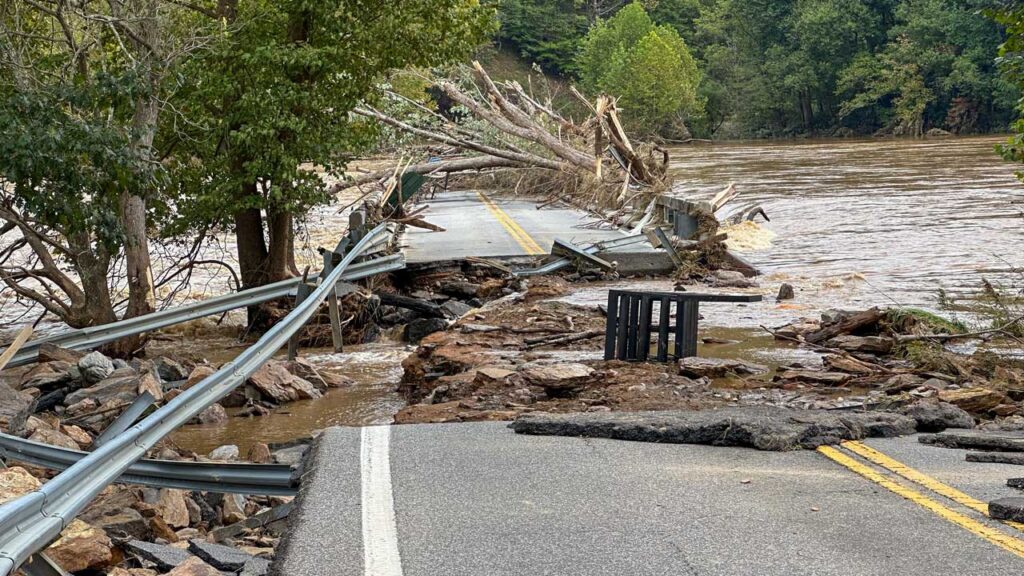
Hurricane Milton: What are hurricanes and is climate change making them more damaging?
Hurricane Milton hit Florida last night bringing tornadoes, floods and risks of storm surges.
Hurricane Milton made landfall as category 3 hurricane, having been downgraded from a category 5 which is the most dangerous type of hurricane. It comes just two weeks after Hurricane Helene devastated the US.
Hurricanes, typhoons, and tropical cyclones are all different names for the same type of tropical storm. Whether a tropical cyclone is called a hurricane, typhoon or cyclone, depends on where in the world it develops.
When a tropical cyclone develops over the Atlantic or eastern Pacific Oceans, and its winds reach speeds of 74 miles per hour, it is called a hurricane. Hurricanes typically affect the USA and the Caribbean
We spoke to Alex Baker, research scientist at the National Centre for Atmospheric Science and the University of Reading, about hurricanes – how they form, their impacts, and if climate change is making them more damaging.
How do hurricanes form?
“Tropical cyclones are born from ‘seeds’ – tropical waves or clusters of individual thunderstorms – in a process lasting from hours to weeks. This occurs at low latitudes over warm tropical oceans and, usually, at least a thousand kilometres from the equator, where the rotation of our planet is sufficient to create a coherent vortex.
“Once formed, tropical cyclones mature, increasing in intensity. Typically, they propagate westward and poleward before reaching the midlatitudes, where they weaken over a cooler ocean surface or transform into frontal weather systems.”
Has this hurricane season been more active than usual?
“Hurricane Beryl was the earliest category 5 Atlantic hurricane on record and it’s unusual to see major hurricanes in June. The hurricane season so far has varied, beginning with unusual early-season activity), followed by a dip in activity in August, caused by unusual weather over north Africa, and activity is picking up quite a lot now.
“We’re likely to see an above-normal level of activity overall, despite the August dip.”
What impact has climate change had on hurricanes?
“One aspect that is relatively well understood is that warming of sea-surface temperatures is likely increasing the intensity of tropical cyclones. Intensity also depends on other atmospheric conditions, but rising ocean temperatures are a key ingredient in the rising likelihood of strong tropical cyclones.
“The hazards of these storms are also affected. Two key ones are precipitation and storm surge. Precipitation related to tropical cyclones is projected to increase for thermodynamic reasons, because a warmer atmosphere can hold more moisture. Research has shown that Hurricane Harvey, which hit Huston in 2017, caused more flooding from intense rainfall than would have been likely without this effect of climate change.
“Storm surge and coastal inundation – the flooding of normally dry land by seawater – is also projected to worsen in the near future due to rising sea levels.”
Is there anything about hurricane Milton that suggests a climate link?
“One of the most striking things about this cyclone is its rapid intensification—from just below category 1 to category 5 in around 24 hours. This makes it the third most intense storm in the Gulf of Mexico, since reliable records began in 1950. Rapid intensification events not only pose greater risks but can also be more poorly forecast.
“One of our recent research papers showed that the kinds of conditions that are conducive to rapid intensification occur more frequently now – there’s been a significant upward trend in this globally over the last four decades.
“Again, rising ocean temperatures are a key driver of this change. North Atlantic temperatures have been significantly above normal this year, raising the probability of rapid intensification events.”
Is the National Centre for Atmospheric Science researching hurricanes?
“Yes! One ongoing project called Huracán is looking into two things: how Atlantic tropical storms can reach midlatitude regions such as Europe, Northeast US, and parts of eastern Canada; and whether this will become a greater risk in future under climate change.”
